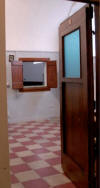
Padre Pio 73-81 (’60-’68)
Investigations, restrictions, last years, death.
In the sixties the very success of Casa Sollievo gave Padre Pio major
difficulties. The steady pouring of contributions became a source of contention
in the Capuchin Order.
The Capuchins had fallen prey of the pyramid scheme financier Giambattista
Giuffre’. The so called “God’s Banker’ gave interests from 30% to as high as
90%. The Capuchins, like many others, invested large sums of money with Giuffre’.
Padre Pio, who had the ultimate administrative control over the funds, was
approached by Capuchin functionaries, and asked to invest. Padre Pio refused. In
the summer of 1958 Giuffre’ declared bankruptcy. The Capuchins faced an economic
disaster.
They approached Padre Pio once again, and he once again refused to give the
money donated to “Casa Sollievo’. At that point a plan emerged to take control
of the hospital from Padre Pio, accusing him of being a poor administrator,
disobedient, and morally unfit.[1]
The plan included bugging the convent with tape recorders and microphones, in
order to get confidential financial information especially from the
administrator of Casa Sollievo Angelo Battisti, and to document inappropriate
behavior between Padre Pio and his spiritual daughters.
[2]
In February 1960, Cardinal Ottaviani, secretary of the Holy Office, sent Padre
Bonaventura da Pavullo to investigate some rumors that had reached the Holy
Office. His report on April 13, 1960, was negative towards Commendator “Angelo
Battisti, administrator of Casa Sollievo”, and also negative towards “three
pious women having a damaging influence on Padre Pio.”[3]
On March 12, 1960 the Holy Office sent Mons. Mario Crovini “to talk to Padre Pio,
and ask if there are any inconveniences going on, and for his suggestion on how
to fix them.” Mons. Crovini went privately to San Giovanni Rotondo On April 20,
1960, with the excuse of personal medical tests to be done at Casa Sollievo. He
stayed two days. He had long conversations with Padre Pio. The friars had a
hostile behavior towards Mons. Crovini.[4]
On April 14, 1960 the superior general Padre Clemente da Milwaukee sent a letter
to the Pope asking for an Apostolic Visitation to fix “grave problems with the
administration of Casa Sollievo”, and also “spiritual questions.”[5]
Padre Clemente: “Just like any other individual religious Padre Pio had a vow of
poverty. Pope Pius XII did not dispense Padre Pio from the wow in general, But
the Pope Pius XII said: “You can do everything with the total income of Casa
Sollievo.” Therefore Padre Pio was always under the vow of poverty, and at the
same time he could dispose of the hospital funds and goods as he saw fit. The
only suspension from the vow of poverty pertained to the hospital Casa Sollievo.”[6]

On May 11, 1960 the first microphone was installed on the internal window
separating the convent from the visitor’s room. The conversation between Padre
Pio and his spiritual daughter was recorded. Padre Giustino and fra Masseo,
listening to the recording thought to hear “tender expressions” and “a kiss”.
The Holy Office was informed, and the tape brought to the Vatican, and the tape
was reheard in the Holy Office, and Padre Giustino was summoned to the Holy
Office “to better interpret the words pronounced in Neapolitan dialect”.[7]
Padre Amedeo da San Giovanni Rotondo who heard the tape with don Terenzi
reported: “The voice recorded was so faint that I could catch only few words,
and never a complete sentence. And I paid attention but didn’t hear any smacking
of a kiss.”[8]
The other microphones were placed in Padre Pio’s cell, and also in the
confessional.
Thirty six taper were made during a three months period.
[9]
Padre Pio discovered himself a microphone under his bed, with the wire passing
through the wall of his cell, to the cell of Padre Giustino. He cut the wire
with a pocket knife.[10]
When Padre Pio discovered the wires he told his friend Francesco Morcaldi.
Morcaldi leaked the story to the press.[11]
Padre Pio said to bishop Cesarano: “My own brethren are doing this to me.”[12]
Padre Paolino told a friend: “We are terrified by these events. We cannot,
however, deny the facts.”[13]
The dispute over the handling of the offers to “Casa Sollievo” continued, and
there were complaints that the money was not handed over for the purpose
designated by the donors.”[14]
There were also complaints of dissents among the friars, and ongoing problems of
fanatic disciples.[15]
Pope John XXIII decided to address the concerns by sending an Apostolic Visitor.

On July 30, 1960 Mons. Maccari went to the convent accompanied by don Giovanni
Barberini. He gave practical dispositions. He ordered that the reservations for
the confessions be handled by a friar; that at confession time, only people with
a reservation could stay in the little church; that the two churches be
separated by an iron gate; that all the recording gear be removed. The
confessions had to last no more than three minutes, or the person will be
removed even before the absolution.
Concerning “Casa Sollievo” Mons Maccari appeared a bit biased, alleging “illicit
enrichment of some staffers,” without examining the books.[16]
Mons. Barberini, the secretary of Mons. Maccari, prohibited the community from
helping Padre Pio. He was denied help in going up and down stairs. One day Padre
Pio fell going down the narrow staircase which joined the big choir to the small
choir. He was left to pick himself up as best as he could.[17]
August 10, 1960: 50th anniversary of Padre Pio’s ordination to
priesthood: sober celebration among many faithful.[18]
On November 3, 1960 Mons. Maccari gave his 208 pages written report to the Holy
Office. Some pearls; “It is a real business thriving on the ignorance of every
social class, exploiting the ingenuous credulity, oscillating between
superstition and magic, in an atmosphere of fake supernatural. It is not true
that the main person in all this is completely in the dark about this colossal
machinery.”[19]
Maccari made some proposals such as removing the fixed time of the Mass,
prohibit bishops and priests from serving the Mass, keep a strict discipline for
the confessions, gradually substituting all the friars with friars from other
provinces.[20]
On December 14, 1960, the Holy Office, fulfilling the recommendations by Mons.
Maccari, ordered that Padre Pio could not talk alone to women, that a new
provincial be named, and remove and substitute gradually all the friars.[21]
On February 1, 1961, the Holy Office delegated one of his consultants for a
mission “top secret” to directly confront Padre Pio about “the pending against
him in the Holy Office. Padre Paolo Philippe talked to Padre Pio on February 22,
1961. Confronted about the accusation of immorality, Padre Pio stated: “It is
not true. Absolutely not true. I never kissed a woman. I tell you in front of
the Lord that I never wanted to kiss my mother. I made her cry because I did not
return her kisses. I thought it was wrong.” Padre Philippe left the same day,
and wrote in his report that he had not been able to convince Padre Pio “of his
wrong behavior and of the need to change.” He continued: “Padre Pio appeared to
me as a man of limited intelligence, very astute and obstinate; a smart peasant
who has no will to change. Padre Pio passed inadvertently from minor gesture of
affection to graver actions, up to the carnal act. And now, after so many years
of a sacrilegious life, maybe he doesn’t realize the gravity of the wrongdoing.
This is the story of all the fake mystics who fell to erotism.” He recommended:
“Suspension of confessions and Mass, and transfer as soon possible to a faraway
convent.”[22]
[23]
On April 18, 1961 Mons. Cesarano, bishop of Manfredonia, visited Pope John
XXIII. The Pope asked about “the women, the recordings, the kisses.” Mos.
Cesarano explained, and the Pope replied: “On Padre Pio, they fooled me.”
On April 19, 1961 in a meeting of the Holy Office it was decided not to accept
the recommendations of Philippe, and to continue with the restrictions of
Maccari.[24]
In 1961-4 the restrictions imposed by the Holy Office on Padre Pio and the
convent continued to be strictly implemented by the superior of the community
Padre Rosario da Aliminusa.[25]
On January 20, 1962. Because of poor sight the Office is commuted with complete
Rosary.
On June 3, 1963 Pope John XXIII died. The friars kept pestering Padre Pio about
the Conclave, until he said: “It’s going to be Montini. Now will you be quiet?”
On June 23, 1963 Montini was elected Pope Paul VI.[26]
In 1959 Card. Montini of Milan gave to Alberto Galletti a message for Padre Pio,
asking for particular prayers. Padre Pio told Alberto that he promised fervent
prayers, and also told Alberto to inform that he would be elected pope, adding:
“Do you understand what you are to tell him? Tell him so because he must get
ready.” Card. Montini was taken by surprise, and told Alberto: “Oh! The strange
notions of the saints!”[27]
[28]
On June 21, 1963 the new pope Paul
VI was elected.
Padre Clemente was a consultant of the Holy Office and of the Congregation for
Religious. He reported: “Paul VI gave me this order: “Liberate Padre Pio from
those restrictions.” Then he said: “You of the Holy Office leave Padre Pio free
to confess. Don’t confine him like a criminal.”[29]
On January 30, 1964 cardinal Alfredo Ottaviani, secretary of the Holy Office,
conveyed to Padre Clemente da Santa Maria in Punta, apostolic administrator of
the capuchin province of Foggia, the disposition from the new pope Paul VI: “The
Holy Father wants that Padre Pio exercises his ministry in full freedom. “Padre
Clemente went to San Giovanni Rotondo and removed all the restrictions imposed
on Padre Pio by the Holy Office.[30]
The condemnations of Padre Pio by the Holy Office have never been revoked.[31]
On December 16, 1964, Padre Pio signed a declaration
as requested by the superior, Padre Carmelo da San Giovanni in Galdo:
“For quite some time news have been published in the press on my situation, as I
was the object of persecution by the ecclesiastical authority. In the presence
of God I feel the need and the duty to deplore those news as false, and to
declare that I enjoy freedom in my ministry and I don’t have enemies and
persecutors. I can publicly affirm that I find in the superiors of my Order, and
in the authority of the Church comprehension, comfort, and protection. And I
don’t need other defenders besides God and his legitimate representatives.”[32]
On February 12, 1965 Cardinal Ottaviani, by disposition of Pope Paul VI, told
Padre Clemente da Santa Maria in Punta that “from now on the had to deal with
Padre Pio as he was not bound by the wow of obedience.” Thus was totally
eliminated any form of restriction.[33]
The Ecumenical Council Vatican II opened on October 11, 1962. It was closed on
December 8, 1965.During the Council several bishops went to the convent and
visited with Padre Pio.

On February 17, 1965 Padre Pio got a dispensation to continue to say Mass in
Latin.[34]
In 1965 Padre Pio was assigned dr. Giuseppe Sala as personal physician.[35]
On July 28, 1966 the town celebrated the 50th anniversary of Padre
Pio’s move to San Giovanni Rotondo. A marble sign on the front
side of the church remembers the event. The town also issued a
commemorative coin in bronze, silver and gold.[36]
On Sunday January 26, 1967 Padre Pio celebrated the 60th anniversary
of the permanent wows. Pope Paul VI, through Cardinal Cicognani congratulated
Padre Pio and authorized him to give a special blessing to the faithful.[37]
November 21, 1966: may celebrate sitting in public.[38]
From March 1966 through April 1967, by disposition of Padre Clemente da Santa
Maria in Punta, Padre Pio was submitted to formal interrogations by Padre
Raffaele da Sant’Elia a Pianisi. The six sessions regarded mostly the events of
the first invisible wounds in 1910.[39]
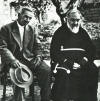
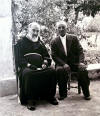

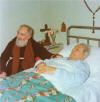 On May 9, 1967: Michele Forgione, Padre Pio’s brother dies at age 85.He had been
living in San Giovanni Rotondo at the home of his daughter Pia, married to Mario
Pennelli.[40]
On May 9, 1967: Michele Forgione, Padre Pio’s brother dies at age 85.He had been
living in San Giovanni Rotondo at the home of his daughter Pia, married to Mario
Pennelli.[40]
On May 25, 1967, an immense crowd gathered to celebrate Padre Pio’s birthday.
There was also the International Convention of the prayer groups. Padre Pio was
ill and greeted the crowds from the window with his famous oversized
handkerchief.[41]
In 1967, last full year of activity, Padre Pio confessed about 25 thousand
people. That is an average of seventy people per day, as from the book of
reservations.[42]
 Padre Paolo Covino with the altar boys. Padre Pio is in a wheelchair.
Padre Paolo Covino with the altar boys. Padre Pio is in a wheelchair.

 Padre Pio in the wheelchair.
Padre Pio in the wheelchair.
On March 29, 1968 Padre Pio starts using the wheelchair.[43]
April 26, 1968 Mary Pyle dies in Casa Sollievo.[44]
May 25, was Padre Pio’s birthday. August 10, was the anniversary of his
ordination to priesthood. September 20, 1968 was celebrated the 50th
anniversary of (visible) wounds. Again immense crowds gathered to honor Padre
Pio.
[45]
On September 12, 1968 in a letter sent by Padre Pio to the Pope Paul VI: "I
offer to you my prayers and my daily suffering, so that the Lord comfort you
with his grace, to continue defending the eternal truth that never changes with
the times change. I thank you for the clear words in the "Humanae Vitae" (The
encyclical letter 'Of human lifè) and confirm my faiths and my unconditional
obedience."[46]
September 20, 1968 50th anniversary of (visible) wounds.
Sunday September 22, 1968 last full day of Padre Pio, started in San Giovanni
Rotondo the Fourth International Convention of the Prayer Groups.
Monday September 23, 1968 at 2:00 AM Padre Pio died.
Sunday, September 22, 1968
[47]
[48]
[49]
It was the starting day of the First International Convention of Prayer Groups.
Many thousands of people gathered in town. Padre Pio sang a High Mass, and the
church was full at the usual time of 5:00 AM. The church was full to capacity.
Padre Pio was in a wheelchair pushed by Padre Pellegrino and Padre Raffaele.[50]
Padre Pio was helped at the altar by Padre Onorato da San Giovanni Rotondo as
deacon, by Padre Valentino da San Giovanni Rotondo as sub deacon, and by Padre
Paolo Covino as master of ceremonies, coordinating the celebrants and the altar
boys.[51]
Whit the accompanying organ, the ‘scola cantorum’ sung “The Missa Jucunda” of
Franco Vittadini. Padre Pio sang appropriately all the parts that he had to. His
voice was tired and frail. The faithful had to strain to hear his feeble,
quavering voice.
When the Mass was ended, the congregation broke into cheers of “Viva Padre Pio!
Auguri Padre Pio!”
[52]
There were no wounds on Padre Pio during last Mass.[53]
As Padre Pio was helped down from the altar, his legs gave way entirely, and he
was about to fall to the ground when brother Bill, and Padre Paolo, who were
nearby, run to the rescue and hugged him from the back holding him steadily to
prevent the fall.
As he was wheeled into the sacristy he
looked around and kept saying feebly: “My children! My children!”[54]
[55]
[56]
Padre Pio made his thanksgiving as usual in the sacristy, and then started into
the church to hear the confessions of men. But after about a dozen of
confessions he had to be helped back. He was taken to the elevator and returned
to his room.[57]
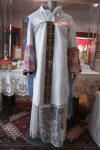
Brother Bill was alone with him, ready to help if needed. He reported that,
while there was a great silence in the corridor and the other rooms, Padre Pio
suddenly broke and interrupted that silent atmosphere, and “in a loud and
unusually strong voice he recited the Our Father”. A little later he received in
his room his nephew Ettore Masone, who brought his five years old son, Pio.
Padre Pio told his little grandnephew: “You carry my name. I want you to live up
to it. Understand?”[58]
After an 8:00 a.m. Mass the crypt of the church of St. Mary of Graces was
blessed by Padre Clemente da Santa Maria in Punta.[59]
Around 10:30 AM Padre Pio appeared at the window of the old choir to bless the
crowd. The people were waving handkerchiefs and crying “Viva Padre Pio”.[60]
At noon he had lunch of a bit of pasta and spinach in his room.[61]
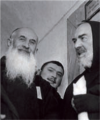 Padre Clemente da Santa Maria in Punta
Padre Clemente da Santa Maria in Punta
At about 11:00 AM , there was the ceremony of laying of the first stone for the
monumental Way of the Cross by Padre Clemente da Santa Maria in Punta, Apostolic
Administrator.[62]
At six Padre Pio asked to be taken to the balcony overlooking the big church,
were Mass was celebrated. After Mass he barely had the strength to lift his arm
to bless the people. He went back to his room where he waved his handkerchief to
an immense crowd who stood with torches and candles in their hands.[63]
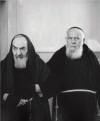 Padre Raffaele da Sant'Elia a Pianisi
Padre Raffaele da Sant'Elia a Pianisi
He told Padre Raffaele: “I belong more to the other world than to this one. Pray
to Our Lord that I might die.”
Seeing Padre Pio in terrible pain, Padre Raffaele summoned dr. Bruno Pavoni from
the Casa Sollievo asking why he was not given a pain med. “He doesn’t want it”
replied dr. Pavone. Padre Raffaele went back to Padre Pio, bended over, and
kissed and embraced him. Padre Pio
reached out, embraced him, and returned the kiss. He said: “Thanks for
everything. May the Lord reward you
for your love.”[64]
The last five hours of Padre Pio
The account of Padre Pio’s last hours is best told in the words of Padre
Pellegrino, the friar whose turn it was to assist him that night.[65]
Padre Pellegrino came on duty at 9 PM, relieving Padre Mariano. Padre Pellegrino
later gave a audiotaped account of the events of that night. They are reported
below.[66]
Padre Pio was in the cell #5. The friars
that helped him used in turn the cell #4. When Padre Pio needed help he used to
press the button of a buzzer, and the friar would run to him. Padre Pellegrino
testified that that night “he pressed the button about six or seven times
between nine and midnight. He continually asked what time it was. He was in bet
bud couldn’t sleep. His eyes were red for crying. It was a sweet and serene
weeping.”
 Padre Pio sitting in the armchair were he died
Padre Pio sitting in the armchair were he died
“At midnight, like a scared boy he begged me “Stay with me, my son”, and
continued to ask the time. And that he said “Boy, did you say Mass?” Padre
Pellegrino replied “It is too early to say Mass.” And Padre Pio said: “Well,
today you will say Mass for me.”
After that Padre Pio asked to confess, and at the end he told Padre Pellegrino:
“My son, if the Lord today calls me, ask all the friars on my behalf to forgive
me for putting them to great inconvenience; and ask my brother friars and my
spiritual children for a prayer for my soul.”
Then Padre Pellegrino asked for a blessing for the friars, the spiritual
children, and the sick people in the “Casa Sollievo.” Padre Pio: “Yes, I bless
all of them; or better still ask the Superior to give himself in my name this
last blessing.”
Then Padre Pio renewed his religious profession.
Padre Pellegrino: “At 1 o’ clock Padre Pio told me: “Listen, my son, her in bed
I’m not breathing well. Let me get up. In the chair I will breathe better.” “He
got up and before sitting in the easy chair he said “Let’s go on the terrace,”
“To my astonishment he was walking straight and steady like a young fellow, and
there was no need for me to hold his arm. After five minutes on the terrace he
returned the old heavy man and asked to go back to his cell.”
“Back in the cell he became pale, and the forehead was dripping a cold sweat,
and the lips started getting blue, and he would say continuously: “Gesu’, Maria.
Gesu’, Maria”, with a voice getting more and more feeble. I wanted to call for
help, but he said: “Don’t wake up anybody.” I tried to leave him to run for
help, and he said again: “Don’t wake up anybody.” I said: “now I have to go.”
And I run to call Padre Mariano, and Fra’ Guglielmo, and the other friars, and I
called doctor Sala on the phone, and he was in the room in about ten minutes.”
“Dr. Sala gave Padre Pio an injection to improve the cardiac activity. Padre Pio
continued to pronounce in a very feeble voice: “Gesu’, Maria. Gesu’, Maria”,
while holding the Rosary in his hands. Dr. Sala called on the phone Mario
Pennelli, the son in law of Padre Pio, dr. Gusso and dr. Giovanni Scarale. In
the meantime I had called the guardian, Padre Mariano, and all the other
friars.”
“Padre Paolo Covino da San Giovanni Rotondo administered the absolution
“sub conditione”, the last rites, and
the apostolic benediction, while all the friars were kneeling in prayer.”
At approximately 2:30 AM of September 23, 1968, Padre Pio gently bent the head
on his chest. He had passed away, seated in his armchair.[67]
[68]
In Padre Pio’s room were Padre Carmelo Di Donato da San Giovanni in Galdo, Padre
Pellegrino Funicelli, Padre Mariano Paladino, Padre Raffaele D’Addario da
Sant’Elia a Pianisi, fra’ Joseph Martin and other friars; dr. Giuseppe Sala, dr.
Giuseppe Gusso, and Dr. Giovanni Scarale.[69]



 Padre Giacomo da Montemarano took pictures of the wounds. The hands, the feet,
the side had no more wounds. The skin was completely normal. There were no signs
of scars.[70]
Padre Giacomo da Montemarano took pictures of the wounds. The hands, the feet,
the side had no more wounds. The skin was completely normal. There were no signs
of scars.[70]







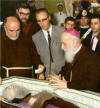


The body of Padre Pio visible in the crypt of the new San Pio church.
On June 1, 2013, in a ceremony
presided by Cardinal Angelo Amato, prefect for the Congregation for the Causes
of Saints, the body of Padre Pio has been made permanently visible. The glass
urn is located in the same spot where it has been in recent years, in a casket,
in the new sanctuary dedicated to Saint Padre Pio in San Giovanni Rotondo. The
mortal remains can be seen in the crypt, through a window in the majestic
pillar from where the enormous arches, holding the magnificent church,
stem
Campanella, S. (2011). Oboedientia and Pax.
La vera storia di una falsa persecuzione. San Giovanni Rotondo: Edizioni
Padre Pio.
Cam11
Covino, P. P. (2007). Ricordi e
testimonianze. San Giovanni Rotondo: Edizioni Padre Pio.
Cov07
Giannuzzo, E. (2012). San Pio da Pietrelcina.
Il travagliato persorso della sua vita terrena. Book sprint edizioni.
Gia12
Ingoldsby, M. (1978). Padre Pio. His Life and
Mission. Dublin: Veritas Publications.
Ing78
Morcaldi, Cleonice (1997). LA MIA VITA VICINO
A PADRE PIO Diario intimo spirituale. Roma: Edizioni Dehoniane.
Cle97
Multiple Authors. (2009). Padre Pio The
wonder worker. New Bedord, MA: Franciscan Friars of Immaculate.
Mul09
Peroni, L. (2002). Padre Pio da Pietrelcina.
Borla.
Per02
Pietrelcina, P. P. (2012). Epistolario IV,
corrispondenza con diverse categorie di persone. San Giovanni Rotondo:
Edizioni Padre Pio.
Epist IV
Rega, F. M. (2005). Padre Pio and America.
Rockford: TAN books.
Reg05
Ruffin, C. B. (1991). Padre Pio: the true
story. Huntington, Indiana: Our Sunday Visitor, Inc.
Ruf91
Schug, J. O. (1987). A Padre Pio Profile.
Petersham, MA: St. Bedès Publications.
Sch87
Winowska, M. (1988). Il vero volto di Padre
Pio. Milano: Edizioni San Paolo.
Win88
[1] Reg05, 235
[2] Gia12, 366
[3] Gia12, 366
[4] Gia12, 367-70
[5] Gia12, 367-8
[6] Sch87, 108
[7] Gia12, 371
[8] Gia12, 371-4
[9] Ruf91, 353
[10] Gia12, 385-6
[11] Ruf91, 353
[12] Ruf91, 353
[13] Ruf91, 353
[14] Ruf91, 354
[15] Ruf91, 355
[16] Gia12, 382-90
[17] Gal95, 174
[18] Gia12, 383
[19] Gia10, 390-1
[20] Gia10, 391
[21] Gia12,392
[22] Cam11, 177-80
[23] Gia12, 194-5
[24] Gia12, 395-6
[25] Gia12, 400-1
[26] Sch87, 70
[27] Ing78, 95-6
[28] Mul99, 32
[29] Sch87, 107
[30] Gia12, 402
[31] Gia10, 045
[32] Gia12, 408
[33] Gia12, 409
[34] Gia12, 409
[35] Gia12, 409
[36] Gia12, 409-10
[37] Gia12, 409
[38] Gia12, 410
[39] Per02, 554-5
[40] Gia12, 412
[41] Gai12, 412
[42] Gia12, 412
[43] Gia12, 412
[44] Gia12, 412
[45] Gia12, 413
[46] Epist. IV, 12-4
[47] Per02, 569-580
[48] Reg05, 248-260
[49] Ruf91, 373-378
[50] Gia12, 415
[51] Cov07, 200
[52] Gia12, 415
[53] Gia12, 517
[54] Win88, 180
[55] Cle87, 155
[56] Cov07, 200
[57] Gia12, 417
[58] Ruf91, 374-5
[59] Cov07, 200
[60] Ruf91, 375
[61] Ruf91, 375
[62] Cov07, 200
[63] Gia12, 717-8
[64] Ruf91, 375
[65] Ing78, 156-9
[66] Gia12, 418-21
[67] Win88, 181-3
[68] Cov07, 204
[69] Cov07, 204
[70] Sch87, 4